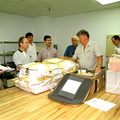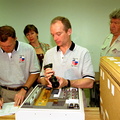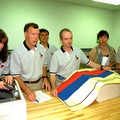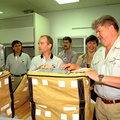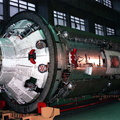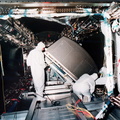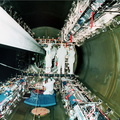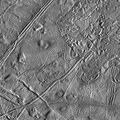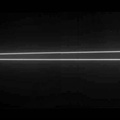
WIKIARCHIVES.SPACE
The Human Spaceflight Archive

Craters ranging in diameter from the limit of resolution, approximately 1.35 kilometers (0.82 miles), up to the remnants of a heavily degraded two-ringed basin (center of the image), approximately 90 kilometers (55 miles) in diameter, can be seen in this image of a region near Callisto's south pole. Craters in this image exhibit a wide variety of degradational (erosional) states, including what appear to be landslide or slump deposits, best seen in the southwestern part of the bright 21 kilometer crater Randver, just east of the center of the image. The relative youth of Randver is evidenced by its bright and easily identifiable ejecta blanket (the materials ejected during the formation of the crater). The northeast facing slopes in this region are typically the brightest portion of the crater rims. Craters in the south and southwestern portions of this image are the most highly modified and degraded, and are therefore considered to be the oldest craters in the area.
Information
- Taken in
- Author
- NASA/JPL/ASU
- Description
-
Craters ranging in diameter from the limit of resolution, approximately 1.35 kilometers (0.82 miles), up to the remnants of a heavily degraded two-ringed basin (center of the image), approximately 90 kilometers (55 miles) in diameter, can be seen in this image of a region near Callisto's south pole. Craters in this image exhibit a wide variety of degradational (erosional) states, including what appear to be landslide or slump deposits, best seen in the southwestern part of the bright 21 kilometer crater Randver, just east of the center of the image. The relative youth of Randver is evidenced by its bright and easily identifiable ejecta blanket (the materials ejected during the formation of the crater). The northeast facing slopes in this region are typically the brightest portion of the crater rims. Craters in the south and southwestern portions of this image are the most highly modified and degraded, and are therefore considered to be the oldest craters in the area.
North is to the top of the image which was taken by the Galileo spacecraft's solid state imaging (CCD) system during its eighth orbit around Jupiter on May 6, 1997. The center of the image is located 73.2 degrees south latitude, 54.4 degrees west longitude, and was taken when the spacecraft was approximately 35,464 kilometers (21,633 miles) from Callisto.
The Jet Propulsion Laboratory, Pasadena, CA manages the mission for NASA's Office of Space Science, Washington, DC.
- Created on
- Thursday 26 March 1998
- Albums
- US SPACE PROGRAM / PROBES / JUPITER / GALILEO / Mission Photos (Edited) / JUPITER / CALLISTO
- Source link
- https://photojournal.jpl.nasa.gov
- Visits
- 16
- Rating score
- no rate
- Rate this photo
- License
- Public Domain
- Modified by WikiArchives
- No (original)
- Downloads
- 0
Powered by Piwigo
